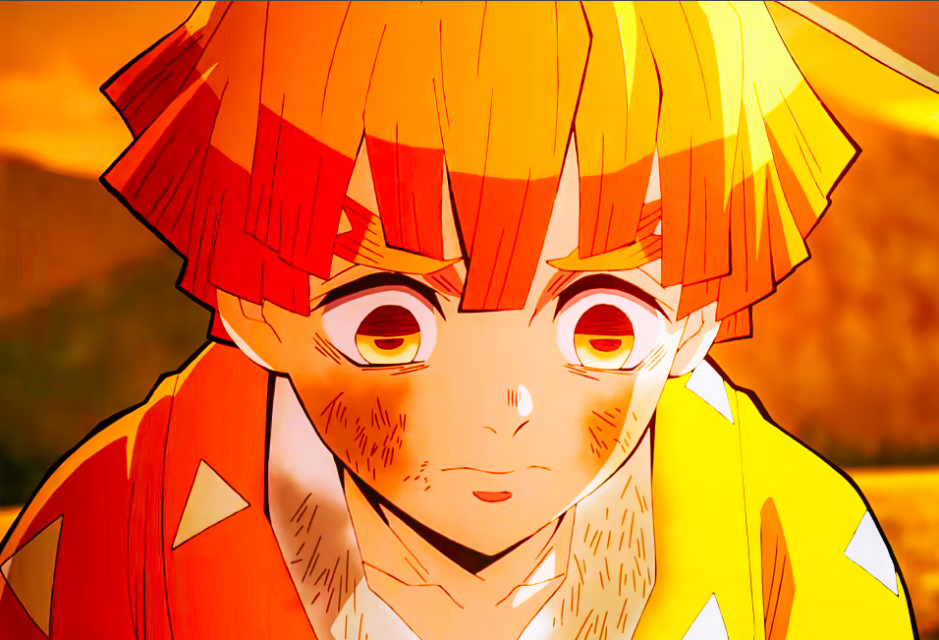The Curious Power of the Cowardly Hero
Zenitsu Agatsuma of Demon Slayer: Kimetsu no Yaiba is an anime oxymoron in motion. One second, he’s hiding behind a tree, screaming at the mere prospect of danger; the next, he’s a blinding flash of bravery, striking down demons with a single thunder-quick flash. On the surface, his over-the-top fright is straight-up comic relief—a break from the series’ gruesome fights and traumatic backstories. But millions of viewers are caught off guard by Zenitsu’s antics, finding that the laughter he provokes often bleeds into real empathy. To understand why this occurs, one must look beyond the surface-level gags to the more profound narrative purposes humor plays. Zenitsu’s comedy isn’t filler; it’s an intentional narrative mechanism that increases tension, deepens characterization, and, ironically, makes some of the show’s most tragic scenes even more emotional.
Table of Contents
Comic Archetypes in Anime—and Where Zenitsu Fits
Anime has a rich history of the “funny coward,” the character whose default reaction is to flee rather than fight: One Piece’s Usopp, Armin’s early moments in Attack on Titan, or Sokka’s self-downing one-liners in Avatar: The Last Airbender. The gag is effective because fear is an experience shared across cultures, and the amplification of it gives viewers a reflection without the baggage of actual-world consequences. Zenitsu, though, turns that archetype to 11. His ear-piercing voice acting, nervous body movements, and melodramatic responses create a ground-level comic tempo. What makes Zenitsu’s humor level stand out is that his timidity exists alongside undeniable competence: in sheer stress—most often when he’s unconscious—he wields Thunder Breathing with deadly accuracy. This tension between coward and competency creates dramatic irony: the viewers realize he can do it even when he can’t, making each breakdown suspenseful. When he finally holds his ground in broad daylight, the reward is both cathartic and comedic, demonstrating that laughter can prepare audiences for awe.
Humor as an Emotional Shock Absorber
Demon Slayer often counterposes idyllic landscapes with horrific violence, and Zenitsu’s responses act as an “emotional shock absorber.” It is known as benign masochism in neuroscience—the pleasure of feeling bad under safe circumstances. Laughter caused by Zenitsu’s hysteria resets the audience’s stress level, so a later horror beat hits harder. Take the Tsuzumi Mansion arc: his comedic fixation on guarding a little box (which contains demonized Nezuko) transitions into a deadly battle with the Tongue and Drum demons. The tonal whiplash heightens fear because the viewer’s defenses have been lowered by comedy. Rather than undermining tension, Zenitsu’s behavior fine-tunes it, demonstrating that comic relief can function like a stretched rubber band: the more it is stretched, the tighter the snap when it is released.
Vulnerability: The Hidden Heart of the Joke
Scholars of comedy tend to quote the “pain-plus-distance” formula: humor occurs when individual pain is observed from a secure distance. Zenitsu’s origin story—an isolated orphan tutored by a rough but loving teacher, Jigoro Kuwajima—adds vulnerability to each gag. His terror arises from genuine self-doubt: he feels he does not deserve the Thunder Breathing style he has been left with. Audiences can sense instinctively that his boisterous breakdowns hide a desperate craving for approval. When Zenitsu thanks Tanjiro tearfully for accepting him in spite of his weaknesses, the scene hits harder exactly because audiences have seen him struggle and worry for episodes. The comedy sets up the runway for an emotional landing, showing that laughter at weakness can spark pity instead of derision.

Pacing and Narrative Breathing Space
Shōnen narrative depends upon increasing stakes: each demon more powerful, each fight gorier. If the narrative offers no respite, even the most harrowing set piece risks fatigue. Zenitsu’s humor structures episodes like musical compositions, inserting rests between fortissimo crescendos. His banter with Inosuke, for instance, punctures the gloom of the Natagumo Mountain arc, giving the audience a chance to process gruesome revelations about Rui’s spider clan. Importantly, these pauses are not throwaway; they often foreshadow character growth. Zenitsu’s hysterical soliloquy on becoming a spider demon is both darkly comedic and foreboding, planting a seed that grows into one of the series’ most uglily lovely action scenes. By structuring comedy as a pacing device, the writers make sure that the emotional high points never run together.
Reception and Resonance in the Fandom
Ask Demon Slayer fans what hooks them, and many will name Zenitsu’s duality. Social media threads are filled with memes of him screaming, “I’M GONNA DIE! ”—yet just as many celebrate his glorious Thunderclap and Flash techniques. Cosplayers reproduce both his tear-streaked panic face and his stoic-looking stance, demonstrating that audiences embrace the full spectrum. Merchandise sales underline this connection: plush dolls of crying Zenitsu sell alongside sleek statues capturing his lightning-fast sword draw. Such commercial success portends more than shallow popularity; it speaks to an emotional connection strong enough to convert into consumer devotion.
Humor, rather than diluting respect for his accomplishments, makes his victories feel hard-won—an effect that storytellers in media platforms try to achieve.
Conclusion: The Lightning Strike Following the Laugh Zenitsu demonstrates that comic relief, when grounded in genuine vulnerability and calculated pacing, can amplify instead of dilute emotional investment. His humor quotient is a storytelling fulcrum: lean one way, and the audience laughs; lean the other, and they gasp. By being both afraid and courageous, Zenitsu teaches us that bravery is not fearlessness but action in the face of fear.
The next time his high-pitched screams ring out during a suspenseful episode, astute viewers may grin—aware that the moment after the laughter, a thunderclap may come.
Frequently Asked Questions
1. Why is Zenitsu always screaming if he’s secretly powerful?
Zenitsu’s screaming indicates real fear and low self-esteem based on abandonment during childhood. His Thunder Breathing ability appears only when asleep because his aware mind undermines his confidence. This dichotomy is a deliberate choice in storytelling that makes his successes unexpected and emotionally rewarding.
2. How does Zenitsu’s comedic role differ between the manga and anime?
Although the manga establishes the same jokes, the anime pushes them further through voice acting, timing, and music cues. Aleks Le and Hiro Shimono (English and Japanese voice actors) bring rapid-fire escalation to Zenitsu’s lines, with scenes feeling louder—and funnier than possible with static panels.
3. Does Zenitsu’s humor spoil the darker aspects of Demon Slayer?
In contrast, his comedy produces a contrast that enhances darkness. By allowing the audience to breathe with laughter, the series can descend further into tragedy without causing exhaustion, thereby maintaining the effect of its darker moments.
4. What payoff is there in terms of narrative for Zenitsu’s comic setup?
Keystone arcs provide Zenitsu with instances of self-aware courage—like in his fight against Kaigaku in the later chapters of the manga, where he sheds self-hatred and uses a self-crafted Thunder Breathing Seventh Form. These thrilling moments are earned precisely because of the long-standing comedic setup.
5. Can Zenitsu’s sense of humor provide lessons about anxiety in real life?
Yes. His character shows that fear does not exclude talent or heroism. Audience members struggling with anxiety might be comforted by seeing a protagonist who freezes, second-guesses himself, and still accomplishes incredible things, implying that vulnerability and strength are not opposing.

